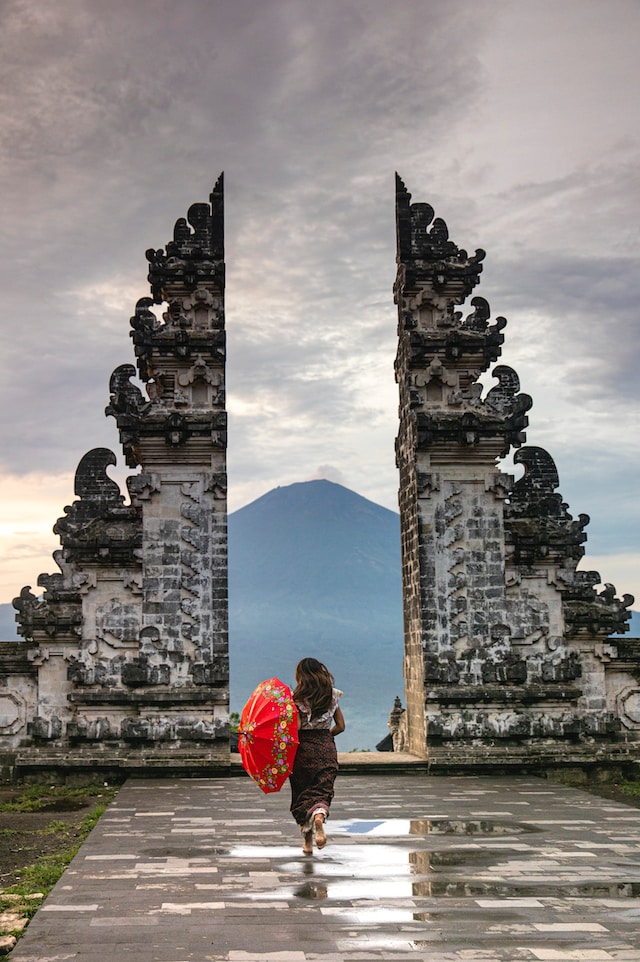Planning a trip to Bali in January? I’ve got you covered with the latest on what to expect from the weather. Known for its tropical climate, Bali’s January weather can be a mix of sunshine and showers, making it a unique time to visit.
 Average Temperature in Bali in January
Average Temperature in Bali in January
When planning your visit to Bali in January, it’s crucial to know what to expect in terms of temperature. I’ve found through my travels and thorough research that Bali’s daytime temperatures in January tend to hover around a comfortable yet warm average.
January falls within Bali’s wet season, which typically means higher humidity levels. Despite this, the temperatures remain quite pleasant. You can expect average daytime highs of about 30°C (86°F), which create perfect conditions for those looking to escape colder climates. The nights bring a slight reprieve with average lows dipping to around 23°C (73°F). These cooler evenings are ideal for enjoying Bali’s vibrant nightlife or just relaxing after a day of adventure.
Here’s a quick overview of the average temperature ranges in January:
| Average High | Average Low |
|---|---|
| 30°C (86°F) | 23°C (73°F) |
Remember, these are averages, so it’s not uncommon to experience slight fluctuations. My advice is to pack light, breathable clothing to stay comfortable during the day and to bring along a layer or two for the cooler evenings.
In addition to the temperature, it’s good to keep in mind that Bali’s weather in January can include sporadic rain showers. These showers are often short-lived and can provide a refreshing break from the heat. They’re also an integral part of what makes Bali’s landscape so lush and vibrant during this time of year. Donning lightweight, water-resistant gear can make your outings more enjoyable, ensuring that the rain doesn’t dampen your experiences.
To truly appreciate Bali’s natural beauty in January, embrace the warm temperatures and occasional showers as part of the island’s charm. Whether you’re exploring the rich culture, lounging on the beaches, or trekking through the verdant countryside, Bali’s January weather adds to the allure that this island paradise has to offer.
Given how popular Bali is as a tropical getaway, it’s no surprise that many travelers find the weather in January to be part of its unique appeal. With the warm temperatures, it’s an especially inviting time for water activities like snorkeling, diving, or simple dips in the ocean to cool down. So don’t forget to pack your swimsuit and sunscreen as you prepare for an incredible Bali adventure.
Rainfall in Bali in January
While discussing the weather in Bali, rainfall is a critical component to consider, especially in January. The wet season is in full swing this month and it brings a significant amount of rainfall. But what does that mean for you? Let’s dive into the specifics.
January sees some of the highest rainfall figures of the year in Bali. On average, there are about 15 to 20 rainy days throughout the month. However, these showers are often heavy but short, lasting for a few hours rather than all day. When the rain clears, it typically leaves behind clear, fresh skies.
Here’s a quick look at the rainfall data you might find useful:
| Average Total Rainfall | Number of Rainy Days |
|---|---|
| 300mm – 350mm | 15 – 20 |
Despite the high likelihood of rain, the showers in Bali are known for being sporadic and can be quite predictable. They usually occur late in the afternoon or during the night. So, if you’re planning your activities, the mornings and early afternoons are your best bet for staying dry.
When it comes to packing, a raincoat or a portable umbrella should be on your checklist. Having waterproof gear can make all the difference, allowing you to enjoy the island’s lush, green landscapes that are especially vibrant this time of year. Remember, the rain plays a crucial role in maintaining the tropical beauty of Bali that tourists so often come to see.
The humidity during January also peaks, ranging around 75% to 85%. This high humidity level might feel quite intense, especially if you’re out exploring or engaging in physical activities. To stay comfortable, opt for light, breathable clothing and stay hydrated. This way, you’ll maximize your enjoyment of Bali’s warm temperatures despite the occasional rain.
Embracing the January weather patterns in Bali is all about understanding and preparation. With the right mindset and some minor adjustments to your plans, you’ll find that the rainfall can add a unique and memorable twist to your experience in this tropical paradise.
Sunlight Hours in Bali in January
While I’ve touched on the frequent rain in Bali during January, it’s equally important to discuss sunlight hours because they play a significant role in planning activities. Despite the common misconception that the wet season completely drenches the island, Bali actually enjoys a fair amount of sunlight even in January. On average, you can expect about 6 to 8 hours of daylight with at least a few hours of sunshine each day. This is a welcoming fact for travelers who might be concerned about the rain overshadowing their vacation.
I can’t stress enough that the sunshine in Bali during January, although not as abundant as other months, still provides plenty of opportunity for adventure and relaxation. Mornings are often the clearest part of the day. So for those who love to soak up the sun, it’s a good idea to schedule beach visits or pool time early in the day. As the afternoon approaches, clouds might gather, preparing for the customary rainfall.
The quality of sunlight during this time is quite intense because Bali is located near the equator. Therefore, taking precautions against UV radiation is something I always recommend. Don’t let the cloudy spells fool you—you can easily get sunburned on overcast days. Remember to wear sunscreen with a high SPF, wear hats and sunglasses, and seek shade periodically to prevent sun damage.
For photographers and nature enthusiasts, the sunlight in January offers superb lighting conditions, especially after a rain shower. The glistening wet landscapes and the tropical foliage dramatically enhanced by the sunlight are truly a sight to behold. Early risers are rewarded with serene sunrises that paint the skies in pastel hues, indicating that the island’s natural splendor doesn’t fade even when the season changes.
While planning your January trip to Bali, include options that allow for flexibility with sunlight hours. Being prepared for sudden shifts in weather ensures that you won’t miss out on the warmth and beauty that Bali’s sun has to offer this time of year. Keep track of the local weather forecast and be ready to adjust your plans on the go for an enriching Balinese experience.
Humidity Levels in Bali in January
Bali’s humid climate is a hallmark of its tropical allure, and January’s humidity levels are among the most palpable. With an average relative humidity hovering around 80% to 85%, it’s clear why a lightweight and breathable wardrobe is essential for any traveler venturing here during this time. Humidity is consistently high due to the wet season, which contributes to the lush landscapes that make the island so enchanting.
I often advise visitors to prepare for the muggy weather by staying well-hydrated and taking breaks during the peak heat hours. It’s not unusual for tourists to be surprised by the dense humidity, even if they’re accustomed to warmer climates.
Adapting to Bali’s Humidity
Adapting to such high humidity involves more than just wearing the right clothing; it affects everything from physical comfort to how you plan your day. For instance, electronic devices and cameras may need extra protection from moisture. Silica gel packets and waterproof cases are simple yet effective solutions.
Keeping to the shade during midday and enjoying the cooler evenings can make a significant difference in comfort. Air-conditioned accommodations and transport are also worth considering for those who find the humidity challenging.
Humidity and Outdoor Activities
The impact of high humidity on outdoor activities cannot be understated. If you’re planning to enjoy Bali’s outdoor adventures, scheduling activities for the morning can help avoid the heat and humidity of the afternoon. Following a rain shower, as humidity levels rise, it’s common to witness the unfolding spectacle of mist rising from the terraced rice paddies and dense forests, offering a truly magical experience.
Although January’s humidity presents some challenges, it’s also integral to Bali’s tropical charm. The moisture in the air enriches the colors of the flora and fauna, providing a vibrant palette that’s a photographer’s dream. With the right preparation and mindset, I find that embracing the humidity leads to the most authentic Balinese experience.
Best Places to Visit in Bali in January
Despite the high humidity, January in Bali brings its own set of attractions. I’ve found that some destinations truly shine during this wet season. Ubud, at the heart of the island, offers a cooler climate and an array of indoor activities like yoga classes, cooking workshops, and art gallery visits which are perfect for the occasionally rainy days. The Ubud Monkey Forest is a must-visit, with its lush surroundings bursting into more vibrant shades of green during January.
Another destination I often recommend is Seminyak. Here, stylish boutiques, top-notch restaurants, and cozy cafés provide ample entertainment when the rain falls. The renowned Seminyak beach might not be ideal for sunbathing this month, but it does present breathtaking views of dramatic waves and moody skies, making it a spectacular spot for photographers and contemplative walks.
For those who are into diving, the Menjangan Island located in the West Bali National Park offers clearer water during the rainy season, allowing for excellent visibility. It’s one of the best times to explore the underwater wonderland, with fewer tourists and an abundance of marine life.
If you’re a culture enthusiast like me, don’t miss out on Pura Ulun Danu Bratan. This water temple sits on Lake Bratan and its serene beauty is enhanced by the misty atmosphere typical of January days. It’s an ideal spot for capturing photos that encapsulate the essence of Bali’s mystique.
While exploring these sites, it’s essential to stay prepared for sudden showers. Lightweight rain jackets and water-resistant bags should be part of your gear. With the right preparation, January’s weather can indeed add a magical touch to Bali’s already enchanting atmosphere. Enveloped in a blanket of humidity and the fresh earthy scent after rain, Bali in January reveals a quieter, yet equally captivating side of the island.
Conclusion
Venturing to Bali in January, you’re in for a unique experience where the weather plays a mystical role in your adventure. Armed with the right gear and a flexible itinerary, you’ll find that the island’s high humidity is no match for your preparedness. Whether you’re capturing the ethereal beauty of the landscapes post-rain or exploring the vibrant indoor scenes of Ubud and Seminyak, there’s an undeniable charm to Bali during this time. So embrace the mugginess, plan for the mornings, and get ready to see a side of Bali that’s truly spellbinding. With a bit of planning, January’s weather can indeed transform your trip into an unforgettable journey.
